Pimax, a high-end VR gaming gear manufacturer, announced two new models of its Crystal line of VR headsets at its 2024 Frontier event on YouTube. The Pimax Crystal Super sets a new high bar for the industry with 29.5 million pixels and the world’s first swappable optical engine, allowing users to select between QLED and micro-OLED panels. The new Pimax Crystal Light offers the same 16.6 million pixels as the existing Pimax Crystal but at a much lower cost, starting at $699.
Pimax also revealed the specifications of the 60G Airlink Module, which employs WiGig technology to enable true high-fidelity wireless PCVR.
Pimax Crystal Super Features Swappable QLED & Micro-OLED Engines
The Pimax Crystal Super appears to be very impressive indeed. Its 29.5 million pixels are a huge increase over the existing Pimax Crystals’ 16.6 million. This results in a greater Field of View (FOV) and higher pixels per degree (PPD).
When combined with Pimax’s new proprietary glass lenses, the company claims the headset to be the clearest and most immersive on the market.
Before proceeding, allow me to explain a few important terms for understanding the related technologies.
PCVR (Personal Computer Virtual Reality)
PC Virtual Reality uses a powerful computer to make the VR experience possible. So, basically, your VR headset is a monitor you put on your head, but it doesn’t render the game.
Advantages:
– The widest VR possibilities at the highest graphic performance
– More customization options and top games such as flight & racing sims
– Not limited to any brand’s VR app ecosystem, so more games are available
Disadvantages:
– Requires a powerful gaming PC
– Requires you to set it up
– Generally, more expensive VR headsets
QLED (Quantum Dot Light-Emitting Diode)
LED lighting in the back and an LCD front with a thin film of quantum dots wedged in between results in higher brightness, larger screen sizes, and lower price tags.
OLED (Organic Light-Emitting Diode)
OLED offers great color accuracy and saturation levels, deeper blacks, better viewing angles, lower power consumption, and a longer lifespan.
While FOV and PPD are important, they are not the only factors to consider when considering the user’s visual experience.
Both QLED and OLED offer distinct advantages for different applications. QLED is a popular choice for high-end VR headsets, but Apple’s introduction of the Vision Pro reinforces the value of OLEDs. The Crystal Super allows users to select between the technologies or opt to use both.
Swapping between the two technologies is especially simple, as the optical engines comprise the display panels and the lenses. Users simply pop one out and the other in.
The QLED engine employs interchangeable glass aspheric lenses, while the micro-OLED engine uses new glass pancake lenses, which Pimax claims are the world’s first of this type.
Regardless of which optical engine is employed, the headset features advanced inside-out tracking through four cameras, eye tracking via eye-tracking for automatic Inter-pupillary Distance (IPD) adjustments, dynamic foveated rendering, and built-in audio.
The Pimax Crystal Super is a true PCVR headset and, as such, omits the XR2 chip and batteries.
Pimax Crystal Super Specifications
Display: QLED+mini LED or Micro-OLED
Resolution: 3840 x 3840 pixels per eye (QLED version, micro-OLED)
Pixel amount: 29.5 million (QLED version, micro-OLED 4K per eye, more pixels than the Apple Vision Pro)
Brightness: 200 nits (QLED version, micro-OLED TBC)
Refresh rate: 72Hz/90Hz/120Hz (QLED version), 70Hz/90Hz (micro-OLED 70Hz/90Hz)
Optics: Glass aspheric lenses (QLED version), glass pancake lenses (micro-OLED)
Audio: Integrated, 3.5mm audio jack 1x, microphones 2x
Tracking: Inside-out, Lighthouse cover optional
VR Mode: PCVR Only
The Pimax Crystal Super will be available in Q4 this year at a starting price of $1799. You can preorder it with a $0.99 deposit by clicking here.
Pimax Crystal Light: High-End PCVR Made Affordable
The new Pimax Crystal Light aims to retain what made the original headset successful while omitting features that are less important to PCVR users. Featuring aspheric glass lenses, a resolution of 2880×2880 in each eye, and a refresh rate of 120 Hz, the headset is a serious performer.
The Crystal Light is intended to be a pure PCVR headset with no standalone capabilities, so it omits the battery and XR2 processor. These omissions result in lower costs and a 30% reduction in weight, which, combined with the improved ergonomics, make this a more comfortable headset than the original model.
Further driving the costs down, the Crystal Light does not feature interchangeable lenses like the Crystal model, nor does it include the eye tracking technology.
To help compensate for potential GPU power limitations, Pimax has upgraded its Fixed Foveated Rendering technology, which is independent of the eye-tracking feature compared to Dynamic Foveated Rendering.
These changes allow Pimax to offer the Crystal Light at a starting price of $699, a huge drop from the original Pimax Crystal‘s price of $1599.
In their Frontier keynote, Pimax highlighted that:
We want to make the Crystal and its clarity available to more PCVR gamers, who want high clarity. We’re thinking about HP Reverb G2 , Rift S, and the Valve Index. If they consider a headset upgrade, where do they go? Many headsets that were previously available to them have now been discontinued.
The Pimax Crystal Light is available for preorder now with a refundable deposit of $30 and will be shipping very soon; Pimax’s estimate is May 2024.
Pimax Crystal Airlink
For those who had concerns that the introduction of the two new models spelled the end of the original Crystal, Pimax has made it clear that this is not the case. From the onset, the Crystal has been designed to be a wireless PCVR headset that delivers high fidelity at full resolution with low latency.
All of this is available without a physical connection to the PC. To achieve this level of performance, the Crystal incorporates the XR2 chip and a battery. The Crystal is the only model in the Pimax line to do so.
Additional hardware is required to enable this level of performance via a wireless connection. The 60G Airlink includes a combined transmitter and receiver and a lightweight dongle that attaches to the headset via a micro-HDMI connection.
The transmitter and receiver connect to the PC through HDMI, completing the package. The 60G Airlink was designed as an integrated package whose dongle adds very little weight to the Pimax Crystal.
Pimax’s 60G Airlink employs Wigig technology to offer higher bandwidth than traditional WiFi solutions, even when compared to WiFi 6E, which is currently the fastest WiFi technology for VR headsets.
Wigig technology also minimizes the heavy visual compression and noticeable latency of WiFi 6E, thereby ensuring an exceptional wireless VR experience overall.
Pimax has stated that the Pimax Crystal 60G Airlink module will:
- Support the full resolution at 2880 x 2880 resolution per eye
- Requires minimal compression
- Supports 90 Hz refresh rate
- Ultra-low latency
- The expected battery life is 2 to 3 hours



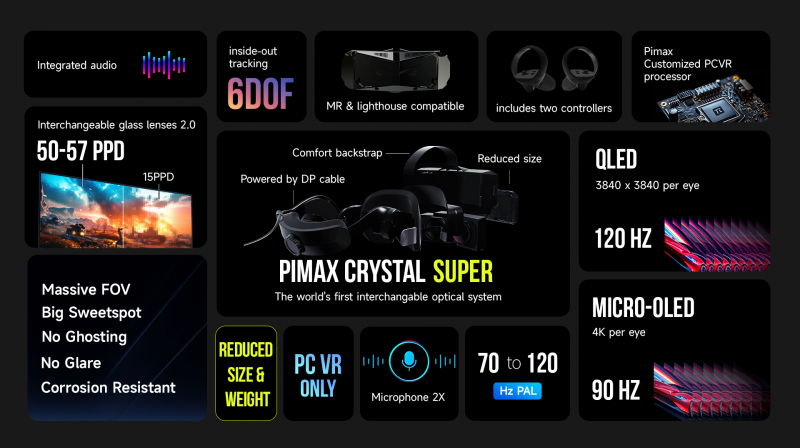
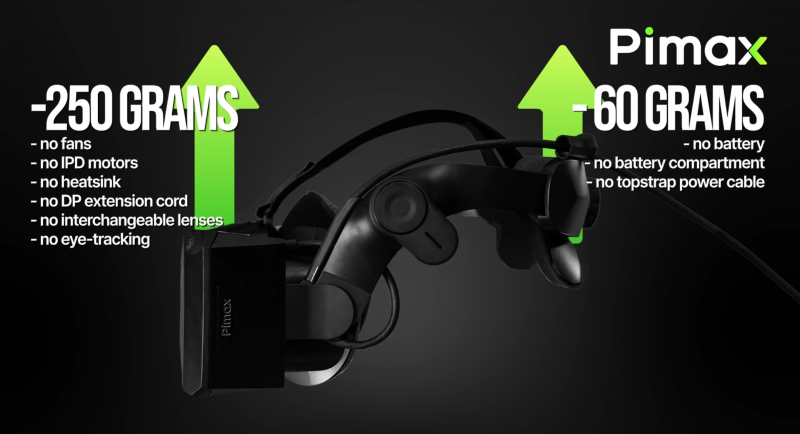
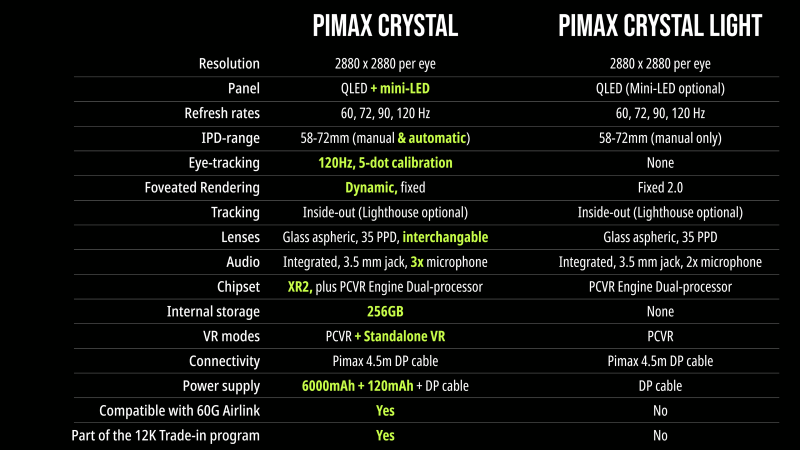
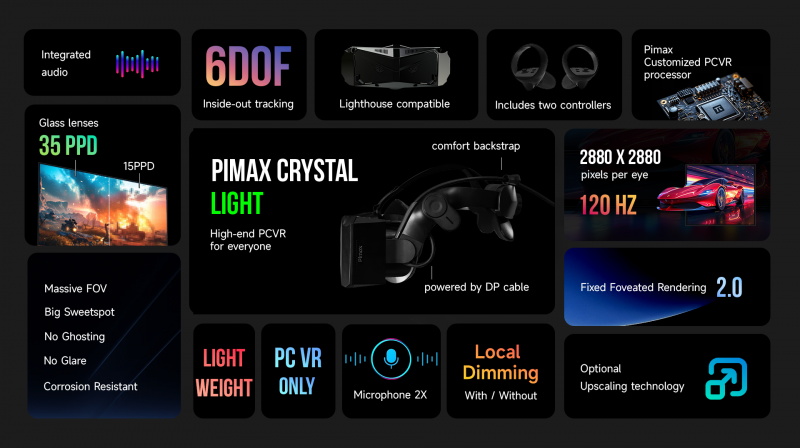
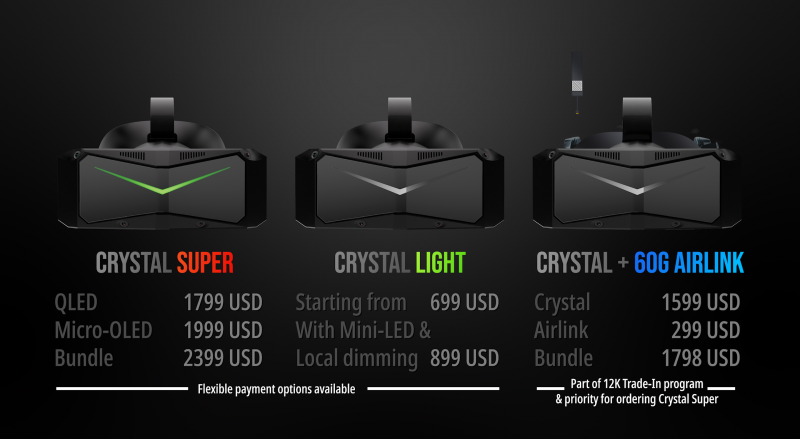
Be the first to comment on "Pimax Crystal Super and Pimax Crystal Light: Two New High-End VR Headsets for Gaming"